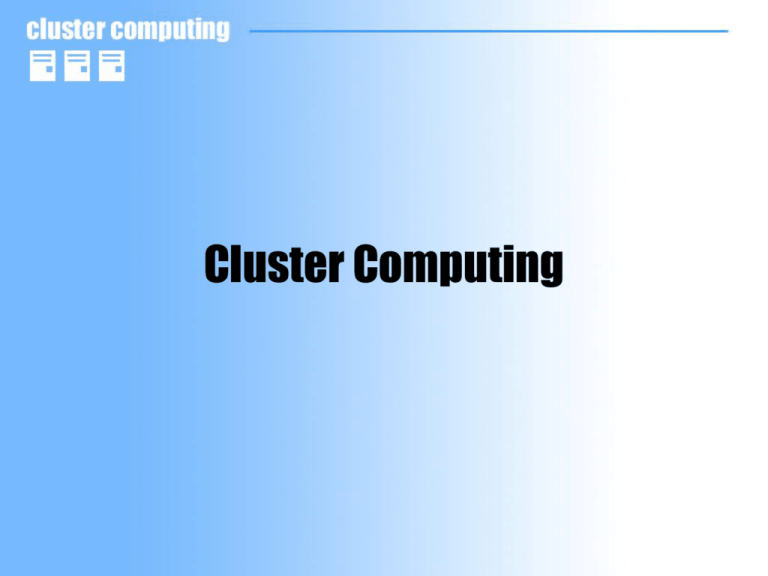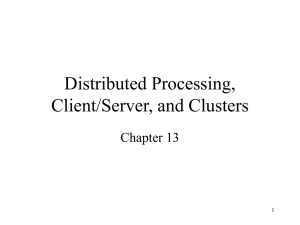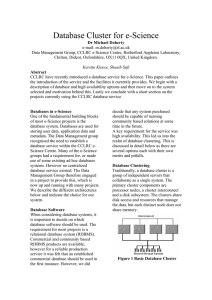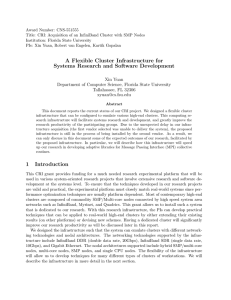Cluster Computing John Kelleher
advertisement

Cluster Computing References • HA Linux Project – • Sys Admin – • http://www-03.ibm.com/servers/eserver/pseries/news/pressreleases/2002/nov/p655.html Tsunami Technologies – • http://arstechnica.com/articles/paedia/cpu/klat2.ars IBM – • http://www.force10networks.com/applications/mediarendering.asp ARS Technica – • http://technet2.microsoft.com/WindowsServer/en/Library/98d46a24-96d8-412c-87d828ace62323d21033.mspx Force10 Networks – • http://channels.lockergnome.com/it/archives/20041022_load_balancing_in_windows_server_ 2003.phtml Microsoft TechNet – • http://www.samag.com/documents/s=1155/sam0101a/0101a.htm Load Balancing in Server 2003 – • http://www.linux-ha.org http://www.tsunamictechnologies.com University of Buffalo – http://www.ccr.buffalo.edu/hotpages/content/u2/u2.htm Who Cares? • • • • • Science Field (SETI) Medical Field (Protein Folding/ VR) Hollywood (SFX) Webmasters Anyone who needs massive amounts of computing power – on a “budget” Outline • • • • Types of computer clusters Who uses them? Benefits of each Costs 3 Types of Clusters • High Availability (HA) • Load Balancing / (LB) • High Performance/Parallel (HP) High Availability Clusters • Two or more servers setup so that if one fails, the other takes over – Share a common data source – Only one accesses data at any time – Monitor each-other by sending “heartbeat” packets between themselves – When one server fails, the work is migrated over to the working one – Users experience a brief break in transmission (typically a few seconds) but not a total loss HA Clusters ( cont ) Load Balancing Cluster • A main server distributes data/application requests to any one of many other servers/nodes – A web server could distribute http requests to appropriate servers based on proximity to client, etc – Often called a “server farm” – Improve performance by splitting up requests Load Balancing ( cont ) High Performance Cluster • Divides computational tasks amongst many different nodes, allowing their shared processing power to be utilized – 296 of the world’s fastest computers are HP clusters (CNET News) – Nodes can communicate with each-other while processing – Processor intensive calculations that would take years on a typical computer, can be completed in a small fraction of the time HP Clusters ( cont ) Costs • The price per gigaflop when using a supercomputer is about 5x more expensive than with a cluster • Clusters have brought the price per GFlop down to around $85 • Supercomputer prices have come down as well though a high-end Sun Fire 15K server with 16 1.0Ghz processors and 64 gigabytes of ram costs $320,000 Costs ( cont ) • Cost of ownership – Important to remember you are not just buying the hardware inside the computer case – Switches, cabling, and interface hardware must be purchased as well – Power consumption of a large cluster (for example 20 nodes) will carry a price tag in excess of $3000 per year – Cost to free up space for a large cluster – Cost to pay employees to set it up and monitor it Case Study University of Buffalo, New York 800 Dell nodes each housing dual 3.2 GHz Xeon Processors Case Study • The University of Buffalo cluster cost $2.3 million to implement – Runs at a peak of around 10 TeraFlops (10 Trillion Floating Point Operations Per Second) – Put them around #40 on the Top500 most powerful computer list – Costs $150,000+ per year in electric costs – For now can only be run at 60% power without causing a power outage – Rendered a video that would have taken a typical home PC 125 days to render, in 8 hours Cost Effective Alternative • Many companies offer “cluster on demand” service – Rent time on clusters from 3rd party companies – Great for companies that do not need that much computing power, all the time – Typically pay per CPU hour: • • • • 60 cents per CPU hour 40 node cluster 72 hours $1700 (most companies have minimum hour requirements) HP Cluster Construction • MPI (Message Passing Interface) – Most widely used standard – Sought to unify parallel programming – Gives programmers a starting point – Works best when programmed with Fortran, but C++ works as well Cluster Construction ( cont ) • Install Fortran ( or C ) Compiler • Configure SSH (need to be able to execute commands at root without asking for a password) • Setup a network file system • Install MPI (from anl.gov) • Edit MPI file to add each node’s hostname • Run test programs! (most steps were taken from http://www-128.ibm.com/developerworks/linux/library/l-cluster2/index.html) Future • Create a HP Cluster in the computer lab • CCSU audio/video server into a high availability setup Questions?











